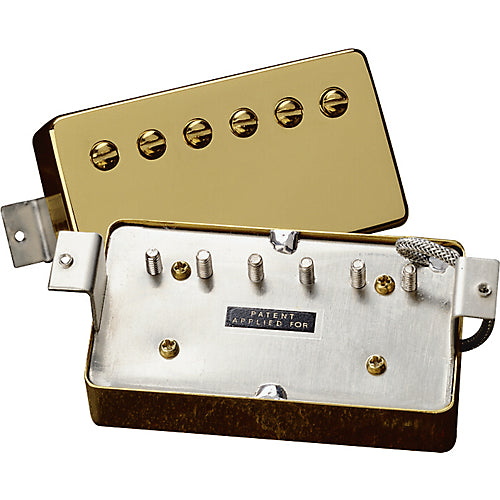Gibson Article: High and Low-Output Pickups
from Gibson.com-
Guitarland has its own language, and until you’ve resided here for a while, some of what seems like even the most basic terminology can be confusing. So it goes with conversations about high-output and low-output pickups. For a long time — before and during the rise of rock ‘n’ roll in the ’50s and ’60s — all pickups were, essentially, low-output. High-output pickups became popular in the ’70s as metal and hard rock came into vogue, and guitarists sought gnarlier tones.
The difference between a high-output and low-output pickup is pretty simple. High-output pickups have more windings than low-output models. That gives them greater resistance and yields a hotter signal. Often high-output pickups are made with ceramic, rather than alnico, magnets as well. If you read about vintage and modern guitar tones, you’ve seen many of these terms before.
Here’s the thing. As appealing as high-output pickups can be — and they’re killer in my 2002 Gibson Flying V, which barks like a dragon on a short leash — if you’re interested in sounding more like Jimmy Page or Eric Clapton than Tony Iommi or Mastodon’s Bill Kelliher, you’re really interested in low-output pickups. The guitarists who defined the sound of classic rock generally played PAF humbuckers and Gibson P-90s in
their vintage Les Pauls, SGs, ES-335s and Flying V’s. And their overdriven tones were propelled by high-gain or super loud amps. The bottom line is, if you’re looking for a wide variety of tones ranging from clean to filthy that can be controlled with precision, then low-output pickups are what you crave. But if you rare to rage like Randy Rhoads, then go for the high-output gusto. Got it?
Now let’s look at some of today’s popular Gibson pickups and put them in high-output/low-output context:
• ’57 Classic: First produced in 1990, these pickups get back to the heart and soul of Gibson’s original humbucker sound palette, with a balanced response that runs from mellow to crunch. They are made to the exact same specs as the original PAFs (Patent Applied For humbuckers – the first iteration of these pickups, which appeared in 1956), including Alnico II magnets, nickel-plated pole pieces, nickel slugs, maple spacers and vintage-style, two-conductor braided wiring. The pickups are also wax potted to remove all internal air space and the risk of microphonic feedback.
• ’57 Classic Plus: Using slightly overwound balanced coils, this humbucker is designed specifically to be a bridge position variation on the ’57 Classic.
• Burstbucker Pros: These pickups are hotter than ’57 Classics, but could be thought of as medium hot instead ofmuy caliente. The fatter, meaner tone here comes from using an Alnico 5, rather than an Alnico 2, magnet. The Burstbuckers get their characteristic harmonic complexity and clarity from slightly unmatched windings. It’s PAF tones with a kick in the pants — if pickups wore pants. Extra noise reduction keeps them quiet even with a high-gain rig.
• ’61 Zebras: One of the high points of the 2014 Gibson model year was the emergence of this new breed of classic style pickups. Like Burstbuckers, these are hotter than vintage ’61 pickups and they have offset coils — one has more windings than the other. With typical Burstbuckers the slug coil has a few hundred more turns than the screw coil, so the slug coil sound tends to dominate; this provides a bit more single coil character. With the 1961 Zebras — named for their black and white plastic fixtures —the wiring offset was reversed to give the screw coil more windings and provide a better balance between the two coils, where neither one dominates. They also have Alnico 5 magnets.
• Dirty Fingers: This is what the first generation of high-output pickups Gibson began making in the 1970s looked, sounded and possibly even smelled like. They are super-hot humbuckers with three powerful ceramic magnets to produce massive output and big tones. These pickups’ overwound-yet-balanced coils also feature adjustable pole pieces, which fine tuning the output of each individual string. If you want maximum output and sustain, this is the pickup.
• P-94s: For vintage tone hounds, Gibson’s P-94s are the coolest pickups to come along in a while. It’s Gibson’s famous P-90-style single coil pickup in a traditional humbucker-size housing. Replacing a traditional humbucker with the P-94 requires no additional routing or other modifications to the guitar. That can turn any Les Paul into an original Gold Top sound-alike. The P-94 features the same vintage, enamel-like coated wiring and Alnico V magnets that are used inside the original P-90. In solid body guitars, P-94s easily overdrive amps and clean up when the volume is backed down. In arch tops, they provide a rich, full tone for jazz and classic blues riffs. Badass!
• Tony Iommi: Here’s a cool and unique pickup. As Gibson’s first Signature Series humbucker, an exclusive configuration of powerful magnets and special windings give the Iommi humbucker the sustain and tone that have made its namesake’s work with Black Sabbath instantly recognizable — a full–shred voice with brilliant clarity. These feature shielded, four–conductor wiring for series, parallel or split coil operation, and are fully wax potted and epoxied for protection against unwanted feedback.
Browse through our stock of Gibson Pickups here!














